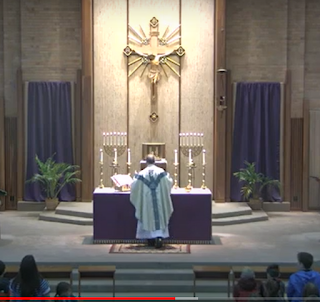 |
| Link to service* The link will port you at about the 30 minute mark. Ten minutes of back-to-congregation follows if you want to get a sense of how that feels. |
Before Vatican II, in the middle of the 1960s, much of the Roman Catholic liturgy (religious service or Mass) was prayed with the priest's back to the congregation.
Vatican II changed many things. It changed the language of the Mass from Latin to the local language to make it more accessible. It also flipped the priest around so he faced the congregation. Incidentally, that placed the altar between the priest and the congregation, separating them.
 |
| Many worship spaces now look like this |
It is not for me to judge whether this is any better or any worse than the other two worship modalities.
We now live in a post-Science world and live in the world of Entertain Me.
While the cameras and booms for mics and the spotlighting does not dominate the worship space, they have certainly become a part of it.
The congregation is not separated from those leading the worship by an altar but by the elevation of the stage. At one level they have become incidental to the worship and in another way have become co-celebrities with those leading the worship.
The transparent window or optically pure lens seems to be morphing into a glittering rhinestone.
Power
Michael Korda wrote a book titled "Power! How to Get It, How to Use It" in 1975.
Korda explained how power has momentum and how very small things throw very long shadows.
Specifically, he discusses how to invade your opponents' space by infringing upon it. Move your pad into their "fair share" of the table-top. Progressively slide your artifacts...matchbook, water glass, pens etc. into their space. If they accept the invasion then they accept your dominance.
Korda also talked through the arcane ordering of power-positions around a conference table. Again, more dominance games. Little things that are opaque to most people but not to somebody who is intent on acquiring power and dominance and then using them.
A worship leader who turns his back on the congregation, and is on the same side of the altar as the congregation, is not signaling dismissiveness to the congregation (the fear of the Vatican II members). He is signaling one-ness with the congregation and is in many ways vulnerable to members of the congregation. It is virtually impossible to enforce Dominance without eye contact.
One wonders if the Priesthood would have been less attractive to the pedophiles if they did not have the altar separating them from the congregation and creating an us/them, predatory/prey divide. One wonders if the forced vulnerability of exposing one's back to potentially angry parents might have stayed some of those impulses.
*Recorded at the Church of the Resurrection in Lansing on the Feast of the Immaculate Conception
The Feast of the Immaculate Conception is when the Catholic Church remembers Mary (the mother of Jesus). Catholic theology holds that Mary was born without original sin. The Biblical support for this belief are the verses about "not putting new wine in old wine skins".

That's an interesting take on it and I appreciate it.
ReplyDeleteWhen it comes to mega-churches (which I loathe) I can understand your concern.
When it comes to a small "evangelical" church, where the pastor/teacher is not dominating the congregation and typically is on the floor level with them, that the third option is demonstrated. One much closer to the original concept of home churches that early Christians were familiar with, and removed from the "distant" worship of a temple in the Old Testament.
I just realized, typing this, is that the evangelical church realizes that God is not on the altar, but among the congregation. That is a major consideration.
The Mennonite/Amish tradition selects a new "Bishop" every year. Every man over a certain age is in the pool and they draw straws.
DeleteThe Bishop for the year is sometimes a young man who is preaching to his elders. When it works well, the young man stretches and grows a great deal during that year.
That is an interesting thought, Ed.
ReplyDeleteMy bestest (and at this point, second oldest) friend in the world, Uisdean Ruadh, is a Catholic (old school) and over the years we have had many interesting and fruitful discussion about the differences - and similarities - between Catholicism and Protestant beliefs. Of the many things I would argue most mainline Protestant Churches (and many Evangelical/non-denominational) have lost, high on the list would be the sense of sanctity and awe. Our church is like our entertainment: loud, flashy, and mostly about us.
In Ezra, I believe we have the first example of a pulpit - the preacher of the Word being elevated not because of their role, but because of God's Word. At one time, I think it was the case that chorales and such were to the side, leaving the altar to the pastor/priest. Evangelicalism has change a lot of that, mostly by completely removing the altar and having everything "up front", as it were.
I would argue it is not an improvement.
I see your point.
DeleteInteresting take on it, and worth thinking about!
ReplyDelete